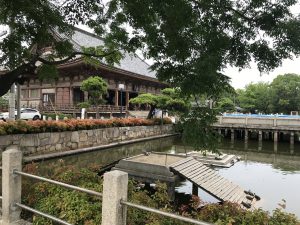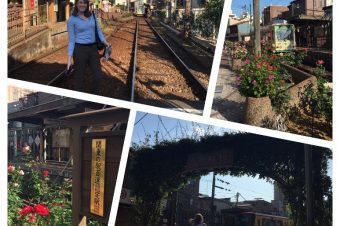Shitennoji Temple is the first state-sponsored temple of Japanese Buddhism founded by Prince Shotoku in 593 ( the 1st year of Emperor Suiko’s era).
Although there were no buildings that were originally built because of suffering from the disaster, the buildings were repeatedly rebuilt for centuries.
The temple enshrines “Gusekanzeonbosatsu” which is the Buddhist identity of Prince Shotoku as the origin of the temple, and the Shitenno are guarding the four sides to surround it.
Shitenno are four heavenly kings of Buddhism.
“Nishimon ishinotorii” is the west entrance which was originally built of wood in the middle of Heian period, but it was changed to stone in 1294 of the Kamakura period.
It is one of the three major torii as a national important cultural asset, and it is also the oldest known torii in Japan.
When I was walking around the precincts of the temple for a while, I was fascinated by the big building called the central temple.
It is said to be “Shitennoji Temple ceremonial cathedral arrangement”, it is one of the oldest architectural styles in Japan, in the form of the middle gate, the five-storied pagoda, the kondo and the lecture hall are aligned from the south towards the north surrounded by the corridor.
Its source is seen in China and the Korean Peninsula, and it is regarded as a valuable architectural style to convey the style of the continent of the 6th – 7th century to today.
The cathedral can be entered at a cheap rate of 300 yen, and it is also allowed to enter the five-storied pagoda to climb up to the top floor.
As I climb up the spiral staircase with excitement at the pagoda which can’t be rarely entered, Buddhist memorial tablet that shaped the five-story pagoda are enshrined on each floor, and the tiles are engraved with the spiritual name of the ancestors of each believer, and they can be able to receive a perpetuity memorial service in the tower.
What I was particularly interested in the cathedral is the drainage groove under the glass door on the side of Tojumon.


This drainage groove seems to have been discovered together with the original foundation stone founded by the excavation investigation, and it was made for the drainage of the rain falling groove of Kondo.
According to the position of this drainage groove, the position of the approach road in front of kondo was proved to be the same as the original founded.
I think this is truly wonderful because it is historically important.
There are turtle ponds where many turtles live in the precincts.
In Buddhism, there is an event called “Hojoe” that releases captured fish and wildlife for offer.
The number of released turtles is increased so far, and now the turtle is said to be the symbol of Shitennoji temple, therefore the pond is the popular place among visitors.
In the northeast of the precincts, there is a beautiful garden called “Gokurakujodo no niwa”.
The structure of the garden was landscaped based on “Nigabyakudo” that is the story taught by the monk Zendo of the ancient Chinese era called Tang.
There are two rivers flowing in the garden, “river of water” representing greediness and obsession, and “river of fire” representing anger and hatred and there is “Byakudo” representing conscience and faith between the two rivers leads to “Gokurakujodo no ike” which is a lotus pond.
The worshiper goes toward “Gokurakujodo no ike” walking along “Byakudo” trying not to fall into two rivers as its story tells.
Also, there are a tea room and ‶Yuyahonjo” that is the important cultural asset of the country in the garden, and you can enjoy the garden not only with eyes but also with your tongue.
It is a garden where you can see beautiful trees and flowers every season.








